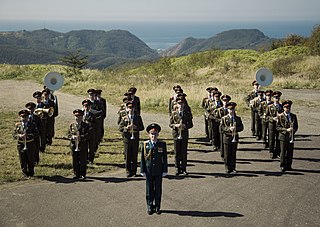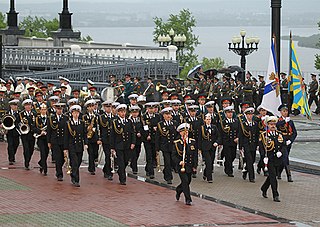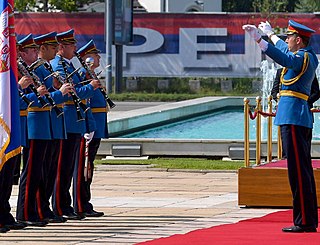
A military band is a group of personnel that performs musical duties for military functions, usually for the armed forces. A typical military band consists mostly of wind and percussion instruments. The conductor of a band commonly bears the title of Bandmaster or Music director. Ottoman military bands are thought to be the oldest variety of military marching bands in the world, dating from the 13th century.

Valery Mikhaylovich Khalilov was an Uzbek-born Russian military band conductor and composer. A lieutenant general in the Russian military, he was the Senior Director of Music of the Military Band Service of the Armed Forces of Russia, most famously conducting the massed Russian military bands at the annual "Victory Day" parade held in the Moscow's Red Square a record 14 times. He died when the plane he was on, en route to Syria, crashed into the Black Sea off Sochi, Russia.

The Military Band Service of the Armed Forces of the Russian Federation serves as the official service of military bands in active service within the Russian Armed Forces and formerly the Soviet Armed Forces. It is part of the Military Band Service Directorate of the General Staff of the Armed Forces of the Russian Federation.

The Military Brass Band of the Commandant Regiment of the Ministry of Defense of Tajikistan, is the official regimental military band of the commandant regiment of the Ministry of Defence of Tajikistan. Being subordinate to the Ministry of Defence, it is the seniormost military band in the Armed Forces of the Republic of Tajikistan.

The Military Band Service of the Armed Forces of the Republic of Belarus is the central military band service of the Armed Forces of Belarus. The band was formed on 1 April 1950 as the Band of the Belorussian Military District. It was expanded into a service in the 1990s after the Independence of Belarus occurred. Its bands participate in military parades, military tattoos, and official ceremonies of Belarus. They perform domestically, regularly performing in the Central Officers House in Minsk, as well as other garrison clubs. The massed bands of the Minsk Garrison is an annual participant in the parades of the Minsk Garrison on Victors Avenue since 2004. The repertoire of the band includes more than 500 compositions of the most important classical music composers and contemporary ones. Bands have performed in festivals in Great Britain, Ireland, Germany, France, Poland, Sweden, and Russia. The band has also played in the Spasskaya Tower military tattoo in 2013, 2016, and 2017. The band is commanded by its Senior Director of Music/Chief Conductor, Lieutenant Colonel Igor Khlebus, since 2019. The artistic director of the band is Colonel Evgueny Dovzhik.

The Presidential Band of the State Security Service of the Republic of Kazakhstan, formerly the Band of the Republican Guard of Kazakhstan, is a military music unit made for state ceremonies carried out by the State Security Service of Kazakhstan.

The Spasskaya Tower International Military Music Festival is an annual military music event and military tattoo held in Moscow on Red Square. Participating in the festival are Russian and foreign military bands, folk groups, and honor guard units of foreign countries. More than 40 countries have taken part in the festival since 2006. It is named after the world-famous Spasskaya Tower of the Moscow Kremlin. Its TV partner is TV Centre. The festival's motto is "To Revive Traditions and Preserve History".

The Valery Khalilov Moscow Suvorov Military Music College is one of the leading military music institutions in Russia. It is a separate branch of the Suvorov Military Schools in Russia, and the oldest of them all.

Central Military Band of the Ministry of Defense of Russia, also known as the Red Army Band is a military band unit of the Russian Armed Forces. It is a branch of the Military Band Service of the Armed Forces of Russia. The current head of the band is Colonel Sergey Durygin.

The Military Band of the Eastern Military District is a military band unit of the Russian Armed Forces. It is a branch of the Military Band Service of the Armed Forces of Russia. The band mainly performs in Khabarovsk and in cities in the Eastern Military District. It is the oldest creative collective in the Russian Far East.

The Military Band of the General Staff of the Armed Forces of Mongolia is the main military band of the Armed Forces of Mongolia. The band was formed in 1950 and began as the foremost musical group of the Mongolian People's Army. It was led for over 30 years by Colonel Navaany Tserenpil who drastically changed the band's style and structure to reflect the Russian model. Tserenpil, who wrote over 100 marches for the band, is known as the Mongolian March King. Today, the MAF Band participates in receptions dedicated to state holidays, parades, and accompanies the visits of heads of state and government to Mongolia.

The Military Band Service of the Ministry of Emergency Situations of Russia is a special military department that is the official military band service for the Ministry of Emergency Situations of Russia, being a branch of the Military Band Service of the Armed Forces of Russia.

Military Band Service of the National Guard of Russia is the official musical department of the National Guard of Russia or the Rosgvardia. It has bands that perform commonly during many Russian national holidays such as Victory Day on May 9 or Russia Day on June 12, as well as military holidays such as Defender of the Fatherland Day on February 23 and National Guardsmen's Day on March 27.

Russian military bands fall under the jurisdiction of the Military Band Service of the Armed Forces of Russia, which is the official music service for the Russian Armed Forces, and led by the Senior Director of Music, a billet of an officer with the rank of a Colonel or a general officer. There are currently between 200 and 300 military bands in the Russian Armed Forces that span across the military as well as all uniformed services in the country. Unlike most western nations, the Armed Forces does not maintain any bands composed of volunteering civilian musicians, as all bands, active or reserve, are manned by graduates of the military music training centers stationed anywhere in the country, as well as of civilian conservatories. While choirs may be attached to military bands, individual staff choirs do not exist in the Russian Armed Forces, since they have attached instrumental ensembles or orchestras. As of 2009, all military musicians are paid around 13,000 rubles ($169.65) for their service in the Armed Forces and other uniformed organizations.

The Indian military bands consists of musicians from the Indian Army, Navy and Air Force. Indian military bands regularly participate in international festivals and take part in celebrations dedicated to various national events. These bands are permanent participants in the Delhi Republic Day parade on the Kartavya Path. Today, the Indian Armed Forces have more than 50 military brass bands and 400 pipe bands and corps of drums. A Tri-Services Band refers to a joint Indian Armed Forces military band that performs together as a unit. At the Spasskaya Tower Military Music Festival and Tattoo in Moscow, the band consisted of 7 officers and 55 musicians. The Military Music Wing of the Army Education Corps is the principal educational institution of the armed forces that provides instruction to musicians of all ranks. Instruction is also provided by the Military Music Training Center and the Indian Navy School of Music.

The Military Band Service of the Armed Forces of the Republic of Azerbaijan is the official military band service of the Azerbaijani Armed Forces. It is part of the command structure of the Ministry of Defense of Azerbaijan.

A mounted band is a military or civilian musical ensemble composed of musician playing their instruments while being mounted on an animal. The instrumentation of these bands are limited, with the musician having to play their instrument, as well as steer the animal to the designated location. Most mounted bands, therefore, use instruments that can easily be held, such as bugles, horns, and Fanfare trumpets. Timpani and glockenspiels are also a common feature, usually located at the head of a band. Although a band that is mounted on any member of the families Equidae and Camelidae are considered to be a mounted band, horses are most commonly used, mostly being employed in military bands in Europe, North and South America, and some parts of Asia.

The Band of the Guard of the Serbian Armed Forces is the official representative military band of the Guard of the Serbian Armed Forces and the Serbian Armed Forces in general. It provides musical support to the President of the Republic and the Serbian General Staff.

The Indian Navy Band, also known as Indian Naval Symphonic Band is the Indian Navy's full time music band. It was established in 1945 and is currently attached to the INS Kunjali. At the time of it commissioning, it had a strength of 50 musicians. All band members have a bachelor's degree from recognized university and can play competently in at least one military sponsored instrument.

The Indian Air Force Band, known officially as No. 1 Air Force Band is a full-time military band of the Indian Air Force. It is considered to be the primary musical unit of the IAF, currently stationed in Jalahalli. Outside the symphony orchestra, other military ensembles have included the following: parade band, jazz ensemble, and vocalist group. It falls under the command of the Directorate of Organisation of the IAF.




















